![]()
![]()
![]()
Use LEFT and RIGHT arrow keys to navigate between flashcards;
Use UP and DOWN arrow keys to flip the card;
H to show hint;
A reads text to speech;
35 Cards in this Set
- Front
- Back
|
What is a leukemia?
|
Clonal malignant neoplasm of hematopoietic cells originating in and accumulating in BM and peripheral blood
|
|
|
What is a lymphoma?
|
Clonal proliferation of malignant WBCs arising in lymphoid tissues (LNs or extranodal lymphatic tissue)
Lymphadenopathy is key feature. |
|
|
What is the most common form of cancer in children?
|
Leukemia (40%)
|
|
|
Infectious cause of lymphadenopathy.
|
Mononucleosis
(and acute HIV) |
|
|
Normal size of LNs.
|
≤1cm
|
|
|
What is the hallmark of hematopoietic malignancy?
|
Clonal hematopoiesis resulting in a homogenous distribution of genetically related malignant cells.
|
|
|
How and when can G6PD isoenzyme analysis determine the presence of clonality?
|
G6PD is x-linked.
Useful in women that are heterozygous for G6PD because random inactivation of X chromosome allows for mosaic of cells that express G6PD isoenzyme A and G6PD isoenzyme B. A monoclonal malignant tumor would only demonstrate a single isoenzyme. |
|
|
How can Ig light chain expression detect malignant clonality?
|
Normal B lymphocytes should express an Ig light chain, should make both kappa and lambda light chains.
If do an immunoperoxidase stain for kappa light chains and a stain for lambda light chains, should see one (not both) in a clonal malignancy. |
|
|
Life of a B Cell.
Begin with location of hematopoietic stem cell. How does this differ with T cells? |
Hematopoietic stemm cell in marror
Lymphoid progenitor migrates to BM, thymus then Early B precursor (heavy chain rearrangement) -->Pre-B -->Naive B Cell (antigen-naive; undergoes heavy and light chain rearrangement) -->migrates to LNs Note: B cell gene rearrangement occurs in marrow T cell gene rearrangement occurs in thymus |
|
|
VDJ recombination allows for ________.
|
Antigen receptor diversity of HSC and lymphoid progenitors in BM
|
|
|
Role of TdT (terminal deoxyribonucleotidyl transferase).
|
Adds random nucleotides to VDJ recombination sites in order to achieve add'l Ag diversity.
|
|
|
How can Southern Blot (DNA) analysis detect clonality?
What would you expect to see on electrophoresis? |
Normal heterogenous population of lymphocytes with include cells w/varied Ig (or TCR in case of T cells) rearrangements.
Southern blotting of a lymphoid malignancy would demonstrate a single band representing a population of cells containing identical gene rearrangement, an indication of clonality. HOWEVER, there would be an additional band, shared with the control electrophoresis as this band represents unrearranged "germline" bands. In short, lymphomas have an extra band on Southern Blot. |
|
|
How is PCR used to detect Ig rearrangements?
What would you expect to see? |
No band in normal.
One band in lymphoma. |
|
|
What specific molecular defects allow for detection of clonality?
|
Oncogenes
Tumor suppressor genes (p53) Genes regulating apoptosis Genes involve din DNA repair |
|
|
After recombination, B lymphocytes express ____.
Then where do they go? What occurs here? Discuss primary and secondary follicles. |
After recombination, B cells express IgM and IgD, and migrate to peripheral lymphoid tissues. The cell is mature, but antigen-naive.
Some B cells become plasma cells in medullary cords and secrete IgM. Most cells to go PRIMARY FOLLICLES. Activtn by specific Ag results in stimulation of B cells proliferation and clonal expansion. B cell centroblasts (dividing cells) form secondary follicles (GERMINAL CENTERS) and are surrounded by Th2 cells. Many germinal centers arise. |
|
|
What is somatic hypermutation?
Where does it occur? |
In germinal centers (secondary follicles), B cells undergo clonal expansion and rapidly proliferate.
The Ig genes of the B cells are susceptible to point mutations in the variable region. This mutative portion = somatic hypermutation. Occurs in germinal center! |
|
|
What is affinity maturation?
|
B cells that have developed mutations during somatic hypermutation are rescued from apoptosis by binding to Ag on dendritic cells. Known as AFFINITY MATURATION.
|
|
|
What is class switch recombination? When does it occur?
What cells are necessary? |
After affinity maturation, B cells switch from IgM to IgG, IgA, and IgE.
This process depends on T helper cells. |
|
|
TdT positive cells are located in the _______.
|
BM, Thymus
TdT- in peripheral lymphoid tissue. |
|
|
Life of a T cell.
|
HSC-->Lymphoid Progenitor Cell-->Early Thymocyte-->Common Thymocyte
-->CD8 (cytotoxic T cell) OR -->CD4 (helper T cell) THIS OCCURS IN THYMUS After this point, travel to LNs and become peripheral T cells |
|
|
Which T cell progenitor is double-negative? What does this mean?
|
Early thymoctes are double negative because don't express CD4 or CD8
|
|
|
Which T cell progenitor is double positive? What does this mean?
|
Common Thymocyte bc expresses CD4 AND CD8
|
|
|
Lower CD numbers correlate with ____.
|
T cells
|
|
|
Higher CD numbers correlate with ____.
Which numbers specifically? |
B cells (CD numbers in the teens--10 included, twenties)
|
|
|
CD34+ is a _______.
|
Hematopoietic SC
|
|
|
CD34+ Tdt+ is a _______.
|
Lymphoid progenitor cell.
|
|

|

|
|

|
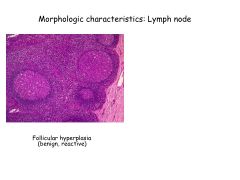
|
|
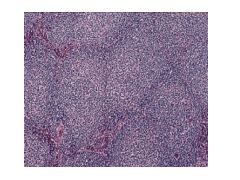
|

|
|
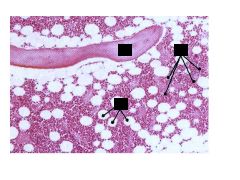
|

|
|
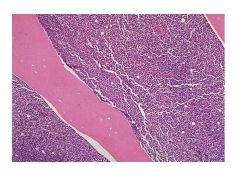
|

|
|
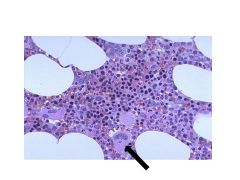
|

|
|
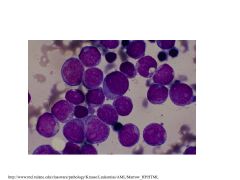
|

|
|
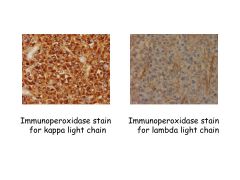
|

|
|
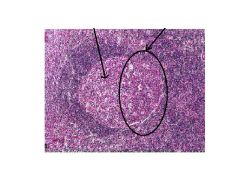
|

|

